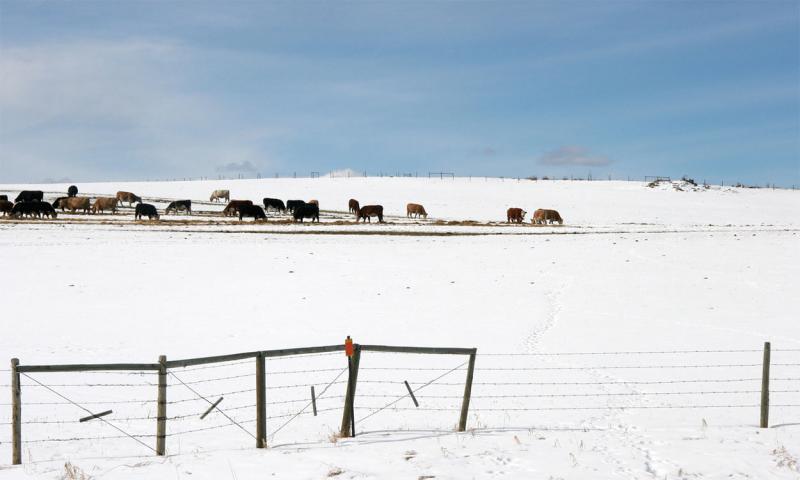
Originally written by Adele Harty, former SDSU Extension Cow/Calf Field Specialist.
Cold temperatures coupled with wind chill and precipitation make it challenging to meet a cow’s nutrient requirements during the winter months. A Polar Vortex is set to bring below normal temperatures to much of the country for the next week. With these below normal temperatures come challenges of ensuring adequate nutrition and protection for livestock, including being prepared to provide additional feed and shelter.
There are some general rules as winter supplementation is considered. These simple practices will help ensure supplementation is done the most cost effective and efficient way possible. First and foremost, test winter forages to determine quality. Depending on the growing and harvest conditions, feed quality will change from year to year and field to field. A forage analysis may cost $25, but it could result in exponential savings in the long run. Use proper sampling procedures to ensure a representative sample because the results are only as good as the sample.
Body Condition Score
Next, monitor body condition score of the cowherd on a regular basis. For example, every 10 days or two weeks, after the cows have been fed, drive back along the feed line and body condition score every 5th or 10th cow and average it. Keeping a running average will allow trends to be observed. Realize different cows will be scored each time, but the herd average will indicate herd changes over time. If the average is 5.2, then 5.0 two weeks later and 4.7 two weeks after that, there is an energy deficiency that needs to be addressed immediately. This 0.5 BCS equates to approximately 50 pounds of weight loss in a month.
If significant body condition loss is observed, a supplementation strategy needs to be determined and implemented. In most cases, lost condition is associated with an energy deficiency, but it could be associated with a protein deficiency that inhibits the rumen microbes from effectively utilizing the energy that is available. A forage analysis will help identify deficiencies so that an effective supplementation strategy can be developed. Refer to the article, Clearing up Confusion on Protein and Energy Supplements,to identify the appropriate supplement for the situation.
Lower Critical Temperature
Now to account for the cold temperatures, the cow’s hair coat has to be considered, as this will determine lower critical temperature (LCT). The table below shows the temperature at which cattle have to expend more energy in order to simply keep warm. This is adapted from D. R. Ames, Kansas State University.
Research indicates that for every degree below LCT, the cow’s energy (TDN) intake needs to increase by 1% to maintain herself. A wet hair coat can increase this energy requirement further. An example with forecasted temperatures of 5 degrees F, the cow’s energy intake would need to increase by 13% if she had a dry heavy winter coat. If additional energy is not provided to overcome this draw on the cow to maintain herself, she will start losing weight. If the cold lasts for an extended period of time, the weight loss could be significant and potentially affect health and reproduction in the future.
| Coat Description |
|
|---|---|
| Summer Coat or wet |
|
| Fall Coat |
|
| Winter Coat |
|
| Heavy Winter Coat |
|
Effective Temperature
Energy needs are based on effective temperature, which is a combination of ambient temperature, wind speed and humidity. With the Polar Vortex, there may be times of greater wind chill, which will be hazardous for livestock and those of us caring for them. This table shows the impact of wind speed on effective temperature, increasing energy needs of the livestock.
| Wind Speed |
|
||||
|---|---|---|---|---|---|
| Calm |
|
|
|
|
|
| 5 mph |
|
|
|
|
|
| 10 mph |
|
|
|
|
|
| 20 mph |
|
|
|
|
|
| 30 mph |
|
|
|
|
|
Management Considerations
Management considerations during these below average temperatures include the following:
- Utilize feeds that will provide additional energy for the animals, but avoid rapid diet changes. Select hays with higher TDN before adding a concentrate to the diet.
- Ensure protein requirements are being met so that the energy can be utilized from the forage.
- Provide protection from wind, whether this is man-made or natural windbreaks.
- Supply bedding as it provides insulation from frozen ground.
- If able, sort cattle into feeding groups so that thin cows can be fed better to meet their increased requirements.
- Provide ample water. If water is iced over and cattle don’t have access, this will limit feed intake and subsequently energy intake. Ruminal fermentation plays a large role in keeping animals warm.
- Finally, make sure you as the caretakers are dressing in layers and protecting yourself from the elements. These extreme temperatures can result in frost bite in a short period of time for any exposed skin.


